1.3: Theories - Family
- Last updated
- Save as PDF
- Page ID
- 89113
\( \newcommand{\vecs}[1]{\overset { \scriptstyle \rightharpoonup} {\mathbf{#1}} } \)
\( \newcommand{\vecd}[1]{\overset{-\!-\!\rightharpoonup}{\vphantom{a}\smash {#1}}} \)
\( \newcommand{\id}{\mathrm{id}}\) \( \newcommand{\Span}{\mathrm{span}}\)
( \newcommand{\kernel}{\mathrm{null}\,}\) \( \newcommand{\range}{\mathrm{range}\,}\)
\( \newcommand{\RealPart}{\mathrm{Re}}\) \( \newcommand{\ImaginaryPart}{\mathrm{Im}}\)
\( \newcommand{\Argument}{\mathrm{Arg}}\) \( \newcommand{\norm}[1]{\| #1 \|}\)
\( \newcommand{\inner}[2]{\langle #1, #2 \rangle}\)
\( \newcommand{\Span}{\mathrm{span}}\)
\( \newcommand{\id}{\mathrm{id}}\)
\( \newcommand{\Span}{\mathrm{span}}\)
\( \newcommand{\kernel}{\mathrm{null}\,}\)
\( \newcommand{\range}{\mathrm{range}\,}\)
\( \newcommand{\RealPart}{\mathrm{Re}}\)
\( \newcommand{\ImaginaryPart}{\mathrm{Im}}\)
\( \newcommand{\Argument}{\mathrm{Arg}}\)
\( \newcommand{\norm}[1]{\| #1 \|}\)
\( \newcommand{\inner}[2]{\langle #1, #2 \rangle}\)
\( \newcommand{\Span}{\mathrm{span}}\) \( \newcommand{\AA}{\unicode[.8,0]{x212B}}\)
\( \newcommand{\vectorA}[1]{\vec{#1}} % arrow\)
\( \newcommand{\vectorAt}[1]{\vec{\text{#1}}} % arrow\)
\( \newcommand{\vectorB}[1]{\overset { \scriptstyle \rightharpoonup} {\mathbf{#1}} } \)
\( \newcommand{\vectorC}[1]{\textbf{#1}} \)
\( \newcommand{\vectorD}[1]{\overrightarrow{#1}} \)
\( \newcommand{\vectorDt}[1]{\overrightarrow{\text{#1}}} \)
\( \newcommand{\vectE}[1]{\overset{-\!-\!\rightharpoonup}{\vphantom{a}\smash{\mathbf {#1}}}} \)
\( \newcommand{\vecs}[1]{\overset { \scriptstyle \rightharpoonup} {\mathbf{#1}} } \)
\( \newcommand{\vecd}[1]{\overset{-\!-\!\rightharpoonup}{\vphantom{a}\smash {#1}}} \)
\(\newcommand{\avec}{\mathbf a}\) \(\newcommand{\bvec}{\mathbf b}\) \(\newcommand{\cvec}{\mathbf c}\) \(\newcommand{\dvec}{\mathbf d}\) \(\newcommand{\dtil}{\widetilde{\mathbf d}}\) \(\newcommand{\evec}{\mathbf e}\) \(\newcommand{\fvec}{\mathbf f}\) \(\newcommand{\nvec}{\mathbf n}\) \(\newcommand{\pvec}{\mathbf p}\) \(\newcommand{\qvec}{\mathbf q}\) \(\newcommand{\svec}{\mathbf s}\) \(\newcommand{\tvec}{\mathbf t}\) \(\newcommand{\uvec}{\mathbf u}\) \(\newcommand{\vvec}{\mathbf v}\) \(\newcommand{\wvec}{\mathbf w}\) \(\newcommand{\xvec}{\mathbf x}\) \(\newcommand{\yvec}{\mathbf y}\) \(\newcommand{\zvec}{\mathbf z}\) \(\newcommand{\rvec}{\mathbf r}\) \(\newcommand{\mvec}{\mathbf m}\) \(\newcommand{\zerovec}{\mathbf 0}\) \(\newcommand{\onevec}{\mathbf 1}\) \(\newcommand{\real}{\mathbb R}\) \(\newcommand{\twovec}[2]{\left[\begin{array}{r}#1 \\ #2 \end{array}\right]}\) \(\newcommand{\ctwovec}[2]{\left[\begin{array}{c}#1 \\ #2 \end{array}\right]}\) \(\newcommand{\threevec}[3]{\left[\begin{array}{r}#1 \\ #2 \\ #3 \end{array}\right]}\) \(\newcommand{\cthreevec}[3]{\left[\begin{array}{c}#1 \\ #2 \\ #3 \end{array}\right]}\) \(\newcommand{\fourvec}[4]{\left[\begin{array}{r}#1 \\ #2 \\ #3 \\ #4 \end{array}\right]}\) \(\newcommand{\cfourvec}[4]{\left[\begin{array}{c}#1 \\ #2 \\ #3 \\ #4 \end{array}\right]}\) \(\newcommand{\fivevec}[5]{\left[\begin{array}{r}#1 \\ #2 \\ #3 \\ #4 \\ #5 \\ \end{array}\right]}\) \(\newcommand{\cfivevec}[5]{\left[\begin{array}{c}#1 \\ #2 \\ #3 \\ #4 \\ #5 \\ \end{array}\right]}\) \(\newcommand{\mattwo}[4]{\left[\begin{array}{rr}#1 \amp #2 \\ #3 \amp #4 \\ \end{array}\right]}\) \(\newcommand{\laspan}[1]{\text{Span}\{#1\}}\) \(\newcommand{\bcal}{\cal B}\) \(\newcommand{\ccal}{\cal C}\) \(\newcommand{\scal}{\cal S}\) \(\newcommand{\wcal}{\cal W}\) \(\newcommand{\ecal}{\cal E}\) \(\newcommand{\coords}[2]{\left\{#1\right\}_{#2}}\) \(\newcommand{\gray}[1]{\color{gray}{#1}}\) \(\newcommand{\lgray}[1]{\color{lightgray}{#1}}\) \(\newcommand{\rank}{\operatorname{rank}}\) \(\newcommand{\row}{\text{Row}}\) \(\newcommand{\col}{\text{Col}}\) \(\renewcommand{\row}{\text{Row}}\) \(\newcommand{\nul}{\text{Nul}}\) \(\newcommand{\var}{\text{Var}}\) \(\newcommand{\corr}{\text{corr}}\) \(\newcommand{\len}[1]{\left|#1\right|}\) \(\newcommand{\bbar}{\overline{\bvec}}\) \(\newcommand{\bhat}{\widehat{\bvec}}\) \(\newcommand{\bperp}{\bvec^\perp}\) \(\newcommand{\xhat}{\widehat{\xvec}}\) \(\newcommand{\vhat}{\widehat{\vvec}}\) \(\newcommand{\uhat}{\widehat{\uvec}}\) \(\newcommand{\what}{\widehat{\wvec}}\) \(\newcommand{\Sighat}{\widehat{\Sigma}}\) \(\newcommand{\lt}{<}\) \(\newcommand{\gt}{>}\) \(\newcommand{\amp}{&}\) \(\definecolor{fillinmathshade}{gray}{0.9}\)Chapter 3: Theories and Family
Making Sense of Abstract Theories
Sociological theories are the core and underlying strength of the discipline. They guide researchers in their studies. They also guide practitioners in their intervention strategies. And they will provide you with a basic understanding of how to see the larger social picture in your own personal life. Theory is a set of interrelated concepts used to describe, explain, and predict how society and its parts are related to each other. The metaphor I've used for many years to illustrate the usefulness of a theory is what I call the “goggles metaphor.” Goggles are a set of inter-related parts that help us see things more clearly. Goggles work because the best scientific components work together to magnify, enlarge, clarify, and expand to our view the thing we are studying.
Theories are sets of inter-related concepts and ideas that have been scientifically tested and combined to magnify, enlarge, clarify, and expand our understanding of people, their behaviors, and their societies. Without theories, science would be a futile exercise in statistics. In the diagram below you can see the process by which a theory leads sociologist to perform a certain type of study with certain types of questions that can test the assumptions of the theory. Once the study is administered the findings and generalizations can be considered to see if they support the theory. If they do, similar studies will be performed to repeat and fine-tune the process. If the findings and generalizations do not support the theory, the sociologist rethinks and revisits the assumptions they made.
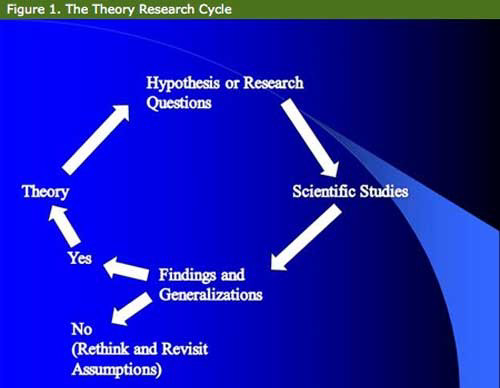
Here's a real-life scientific example. In the 1960's two researchers named Cumming and Henry studied the processes of aging. They devised a theory on aging that had assumptions built into it. These were simply put, that all elderly people realize the inevitability of death and begin to systematically disengage from their previous youthful roles while at the same time society prepares to disengage from them (see Maddox et al. 1987 The Encyclopedia of Aging, Springer Pub. NY) for much more detail. Cumming and Henry tested their theory on a large number of elderly persons. Findings and generalization consistently yielded a “no” in terms of support for this theory. For all intents and purposes this theory was abandoned and is only used in references such as these (for a more scientifically supported theory on aging Google “Activity Theory and/or Continuity Theory”). Theories have to be supported by research and they also provide a framework for how specific research should be conducted.
By the way theories can be used to study society-millions of people in a state, country, or even at the world level. When theories are used at this level they are referred to as Macro Theories, theories which best fit the study of massive numbers of people (typically Conflict and Functional theories). When theories are used to study small groups or individuals, say a couple, family, or team, they are referred to as being Micro Theories, theories which best fit the study of small groups and their members (typically Symbolic Interactionism or Social Exchange theories). In many cases, any of the four main theories can be applied at either the macro or micro levels.
There are really two distinct types of theories. First, Grand Theory is a theory which deals with the universal aspects of social processes or problems and is based on abstract ideas and concepts rather than on case specific evidence. These include Conflict, Functionalism, Symbolic Interactionism, and Social Exchange Theories; second, Middle-Range Theory is a theory derived from specific scientific findings and focuses on the interrelation of two or more concepts applied to a very specific social process or problem. Robert K. Merton (1910-2003) was a functional theory-based sociologist who taught the value of using smaller more specifically precise theories in trying to explain smaller and more specific social phenomena. These theories include Continuity, Activity, Differential Association, and Labeling theories. (see American Sociology Association, Theory http://www.asatheory.org/).
Let's consider the 4 grand theories one at a time. The Conflict Theory is a macro theory. Macro theory is a sociological theory designed to study the larger social, global, and societal level of sociological phenomena. This theory was founded by a German philosopher, economist, sociologist, and revolutionary (1818-1883). Marx was a witness to oppression perpetrated by society's elite members against the masses of poor. He had very little patience for the capitalistic ideals that undergirded these powerful acts of inhumane exploitation of the average person. To him struggle was innate to all human societies. Later another German named Max Weber (1864-1920; pronounced “Veybur”) further developed this sociological theory and refined it to a more moderate position. Weber studied capitalism further but argued against Marx's outright rejection of it.
Conflict Theory
Conflict theory is especially useful in understanding war, wealth and poverty, the haves and the have nots, revolutions, political strife, exploitation, divorce, ghettos, discrimination and prejudice, domestic violence, rape, child abuse, slavery, and more conflict-related social phenomena. Conflict theory claims that society is in a state of perpetual conflict and competition for limited resources. Marx and Weber, were they alive today, would likely use Conflict Theory to study the unprecedented bailouts by the US government which have proven to be a rich-to-rich wealth transfer.
Conflict Theory assumes that those who have perpetually try to increase their wealth at the expense and suffering of those who have not. It is a power struggle which is most often won by wealthy elite and lost by the common person of common means. Power is the ability to get what one wants even in the presence of opposition. Authority is the institutionalized legitimate power. By far the bourgeoisie, wealthy elite (royalty, political, and corporate leaders), have the most power. Bourgeoisie are the “Goliaths” in society who often bully their wishes into outcomes. The Proletariat are the common working class, lower class, and poor members of society. According to Marx (see diagram below) the Bourgeoisie and Proletariat cannot both have it their way and in order to offset the wealth and power of the Bourgeoisie the proletariat often rise up and revolt against their oppressors (The French, Bolshevik, United States, Mexican, and other revolutions are examples).
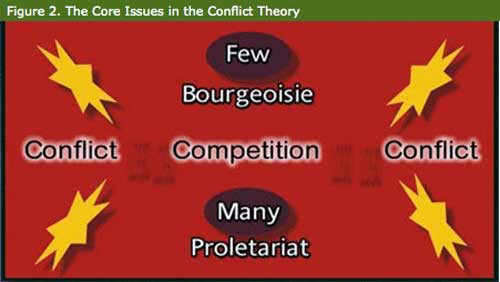
In fact Marx and Weber realized long ago that society does have different classes and a similar pattern of relatively few rich persons in comparison to the majority who are poor-the rich call the shots. Look below at the photographic montage of homes in one US neighborhood which were run down, poor, trashy, and worth very little. They were on the West side of this gully and frustrated many who lived on the East side who were forced to drive through these “slums” to reach their own mansions.

The Conflict Theory has been repeatedly tested against scientifically derived data and it repeatedly proves to have a wide application among many different levels of sociological study. That is not to say that all sociological phenomena are conflict-based. But, most Conflict theorist would argue that more often than not Conflict assumptions do apply. Feminist theory is a theoretical perspective that is couched primarily in Conflict Theory assumptions.
Functionalism or Structural Functionalism Theory
The next grand theory is called Functionalism or Structural Functionalism. Functionalist theory claims that society is in a state of balance and kept that way through the function of society's component parts. This theory has underpinnings in biological and ecological concepts (see diagram below). Society can be studied the same way the human body can be studied-by analyzing what specific systems are working or not working, diagnosing problems, and devising solutions to restore balance. Socialization, religious involvement, friendship, health care, economic recovery, peace, justice and injustice, population growth or decline, community, romantic relationships, marriage and divorce, and normal and abnormal family experiences are just a few of the evidences of functional processes in our society.
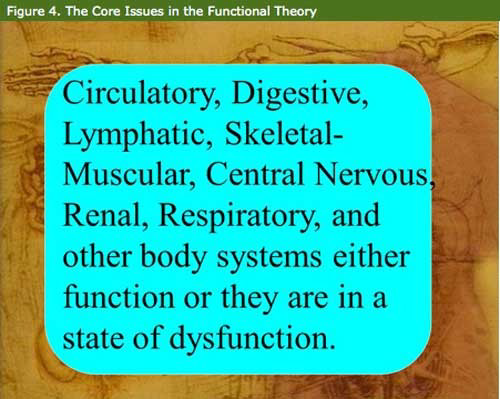
Sure, Functionalists would agree with Conflict Theorists that things break down in society and that unfair treatment of others is common. These break downs are called Dysfunctions, breakdowns or disruptions in society and its parts, which threaten social stability. Enron's collapse, the ruination of 14,000 employees' retirement funds, the loss of millions in shareholder investments, and the serious doubt it left in the mind of US investors about the Stock Market's credibility and reliability which lasted for nearly a decade are examples of dysfunctions in the economic sector of the economy. But, Functionalists also look at two types of functions, manifest and latent functions. Manifest functions is are the apparent and intended functions of institutions in society. Latent functions are the less apparent, unintended, and often unrecognized functions in social institutions and processes.
Back to Enron, the government's manifest function includes regulation of investment rules and laws in the Stock market to ensure credibility and reliability. After the Enron collapse, every company offering stocks for trade underwent a government supervised audit of its accounting processes in order to restore the public trust. For the most part balance was restored in the Stock Market (to a certain degree at least). There are still many imbalances in the investment, mortgage, and banking sectors which have to be readjusted; but, that's the point society does readjust and eventually recover some degree of function.
Does the government also provide latent or accidental functions to society? Yes. Take for example the US military bases. Of all the currently open US military bases, all are economic boons for the local communities surrounding them. All provide jobs, taxes, tourism, retail, and government contract monies that would otherwise go somewhere else. When the discussion about closing military bases comes up in Washington DC, Senators and members of Congress go to work trying to keep their community's bases open.
As you can already tell, Functionalism is more positive and optimistic that Conflict Theory (the basis for much criticism by many Conflict Theorists). Functionalists realize that just like the body, societies get “sick” or dysfunction. By studying society's parts and processes, Functionalists can better understand how society remains stable or adjust to destabilizing forces when unwanted change is threatened. According to this theory most societies find that healthy balance and maintain it (unless they don't and collapse as many have in the history of the world. Equilibrium is the state of balance maintained by social processes that help society adjust and compensate for forces that might tilt it onto a path of destruction.
Getting back to the Conflict Example of the gully separating extremely wealthy and poor neighborhoods, look at this Habitat for Humanity picture below. I took this close to my own home, because it represents what Functional Theorists claim happens-component parts of society respond to dysfunctions in ways that help to resolve problems. In this house the foundation was dug, poured, and dried within a week. From the foundation to this point was three working days. This house is now finished and lived in, thanks mostly to the Habitat non-profit process and the work of many volunteers. From the Functionalism perspective, optimism is appropriate and fits the empirical data gathered in society.

Symbolic Interactionism Theory
Interactionism comes in two theoretical forms, Symbolic Interaction and Social Exchange. By far, my favorite sociological theory is Symbolic Interactionism. Symbolic Interaction claims that society is composed of ever present interactions among individuals who share symbols and their meanings. This is a very useful theory for understanding other people; improving communications; learning and teaching skills in cross-cultural relations; and generally speaking, “not doing harm to your roommates” as many of my students often say after understanding this theory. Values, communication, which hunting, crisis management, fear from crime, fads, love and all that comes with it, “evil and sin,” what's hot and what's not, alien abduction beliefs, “who I am,” litigation, mate selection, arbitration, dating joys and woes, and both personal national meanings and definitions (September 1, 2001-WTC) can all be better understood using Symbolic Interactionism.
Once you realize that individuals are by their social natures very symbolic with one another, then you begin to understand how to persuade your friends and family, how to understand others' points of view, and how to resolve misunderstandings. This theory magnifies the concepts of meanings. Think about these three words, LOVE, LUST, and LARD. Each letter is a symbol. When combined in specific order, each word can be defined. Because we memorize words and their meanings we know that there is a striking difference between LOVE and LUST. We also know that LARD has nothing to do with either of these two terms (for most people at least). Contrast these word pairs, hate versus hope, help versus hurt, advise versus abuse, and connect versus corrupt. These words, like many others, carry immense meaning and when juxtaposed sound like the beginning of philosophical ideas.
Symbolic Interactionism makes it possible for you to be a college student. It makes it so you understand your professors' expectations and know how to step up to them. Our daily interactions are filled with symbols and an ongoing process of interactions with other people based on the meanings of these symbols. “How's it going?” Ever had anyone you've greeted actually answer that question? Most of us never have. It's a greeting, not a question, in the US culture.
If you want to surprise someone, answer them next time they say How's it going? If they have a sense of humor, they might get a kick out of it. If not, you may have to explain yourself. Symbolic Interactionism Theory explores the way we communicate and helps us to understand how we grow up with our self-concept (see socialization chapter). It helps you to know what the expectations of your roles are and if you perceive yourself as doing a good job or not in meeting those expectations.
There are many other Symbolic Interactionism concepts out there to study, let's just talk about one more-The Thomas Theorem or Definition of the Situation. Thomas Theorem is often called the “definition of the situation” which is basically if people perceive or define something as being real then it is real in its consequences. I give a few examples from the media, a woman was diagnosed as HIV positive. She made her funeral plans, made sure her children would be cared for then prepared to die. Two-years later she was retested. It turned out her first test results were a false positive, yet she acted as though she had AIDS and was certainly going to die soon from it.
In a hypothetical case, a famous athlete (you pick the sport) defines himself as invincible and too famous to be held legally accountable for his criminal behavior. He is subsequently found guilty. A politician (you pick the party and level of governance) believes that his/her constituents will tolerate anything. When he/she doesn't get reelected no one is surprised. The point is that when we define our situation as being real, we act as though it is real (regardless of the objective facts in the matter).
Symbolic Interactionism is very powerful in helping people to understand each other. Newlyweds, roommates, life-long friends, young adult children and their parents, and teammates can all utilize the principles to “walk a mile in the other's shoes;” “see the world through their glasses;” and/or simply “get it.” One of the major realization that comes with Symbolic Interactionism is that you begin to understand the other people in your life and come to know that they are neither right nor wrong, just of a different point of view. They just define social symbols with varying meanings.
To understand the other person's symbols and meanings, is to approach common ground. Listen to this statement by Rosa Parks (1913-2005), “All I was doing was trying to get home from work.” In 1955 when she refused to give up her seat on the bus to a White person, it proved to be a spark for the Civil Rights Movement that involved the leadership of Martin Luther King Jr. and many other notable leaders. It was Rosa Park's simple and honest statement that made her act of defiance so meaningful. The lion share of the nation was collectively tired and sick of the mistreatment of Blacks. Many Whites joined the protests while others quietly sympathized. After all that was written in the history books about it, a simple yet symbolic gesture by Rosa Parks symbolically started the healing process for the United States.
Social Exchange Theory
The remaining theory and second interactionist theory is Social Exchange. Social Exchange claims that society is composed of ever present interactions among individuals who attempt to maximize rewards while minimizing costs. Assumptions in this theory are similar to Conflict theory assumptions yet have their interactistic underpinnings. Basically, human beings are rational creatures, capable of making sound choices once the pros and cons of the choice are understood. This theory uses a formula to measure the choice making processes.
(REWARDS-COSTS)=OUTCOMES
or
(“What I get out of it”-“What I lose by doing it”)=”My decision”
We look at the options available to us and weigh as best we can how to maximize our rewards and minimize our losses. Sometimes we get it right and other times we make a bad choice. One of the powerful aspects of this theory is the concept of Equity. Equity is a sense that the interactions are fair to us and fair to others involved by the consequences of our choices. For example, why is it that women who work 40 hours a week and have a husband who works 40 hours per week do not perform the same number of weekly hours of housework and childcare? Scientists have surveyed many couples to find the answer. Most often, it boils down to a sense of fairness or equity. Because she defines it as her role to do housework and childcare, while he doesn't; because they tend to fight when she does try to get him to perform housework, and because she may think he's incompetent, they live with an inequitable arrangement as though it were equitable (don't get me started on the evidence that supports men sharing the actual roles of housekeepers and childcare providers-see Joseph Pleck, “Working Wives/ Working Husbands” Sage Pub, CA).
Each of us tries constantly to weigh pros and cons and to maximize the outcomes of our choices. I often provide a rhetorical challenge to my students when I ask them to go down to the cafeteria, pick the least attractive person they can find, take them on a date where they drive and they pay for everything, then give the person a 7 second kiss at the end of the date. “Why would we do that?” they typically ask. “That's my point,” I typically reply, having increased a bit of their understanding of the Social Exchange Theory.
Any of the four theories can be used to study any individual and collective behaviors. But, some do work better than others because their assumptions more precisely match the issue of interest. Divorce might be studied from the Conflict Theory to understand how things become adversarial and how and why contested divorces sometimes become violent. Divorce might be studied from the Functionalism Theory to understand how divorce is a means to resolving untenable social circumstance-it is a gesture designed to restore balance and equilibrium. Divorce might be studied using the Symbolic Interactionism Theory to identify how people define their roles before, during, and after the divorce and how they reestablish new roles as unmarried adults. Divorce might also be studied using the Social Exchange Theory to understand the processes and choices that lead to the final divorce decision, distribution of assets, child custody decrees and the final legal change of status (see Levinger and Moles, “Divorce and Separation: Context, Causes, and Consequences” 1979, Basic Books).
I've enclosed a simple summary sheet of the four basic theories used most by sociologists. It serves well as a reference guide, but can't really replace your efforts to study sociological theories in more detail. On the next page I've enclosed a self-assessment that may help you to assess your leanings towards these four main theories and two others that are often used by sociologists. On the self-assessment don't be surprised if you find that all four theories fit your world-view. Keep in mind they have been extensively studied for a very long time.
Family Systems Theory
When understanding the family, the Family System Theory has proven to be very powerful. Family Systems Theory claims that the family is understood best by conceptualizing it as a complex, dynamic, and changing collection of parts, subsystems and family members. Much like a mechanic would interface with the computer system of a broken down car to diagnose which systems are broken (transmission, electric, fuel, etc.) and repair it; a therapist or researcher would interact with family members to diagnose how and where the systems of the family are in need of repair or intervention. To fully understand what is meant by systems and subsystems look at Figure 6 below. Family Systems Theory comes under the Functional Theory umbrella and shares the functional approach of considering the dysfunctions and functions of complex groups and organizations.
Figure 6 shows the extended family system which centers around a middle-aged couple named Juan and Maria Rodriguez. Juan is a tenured university professor who lives with his parents, his wife's widowed mother, his two children Anna and José, Anna's husband Alma and the 3-month old triplets Anna just delivered C-section. Notice that Maria's father passed away, so he has an X over his place in this diagram. Because Juan is financially established he can support the large extended family. This represents a 4-generation complex family system. There are three couples living within this home, Juan and Maria, Grandpa and Grandma, and Alma and Anna. But, there are various levels of strain felt by each couple.
Today multi-generational family systems are becoming more common, but are typically three generations where the married adult child and his or her spouse and children move back home. Juan and Maria raised their two children Anna and José with tremendous support from grandparents. Maria's mother was a college graduate and has been a big help to José who is a sophomore in junior college and a basketball team member. Juan's mother and father are the oldest family members and are becoming more and more dependent. Juan's mother requires some daily care from Maria.
In fact, Maria has the most individual strain of any family member in this family system. Juan and Maria have each felt a strain on their marriage because of the strains that come from each subsystem and family member who depends upon them. Think about it-they both have in-laws in the house; they both contribute to the care needs of the elderly family members; and they both try to support their son's basketball games and tournaments. But, most of all, there are three brand new babies in the house.
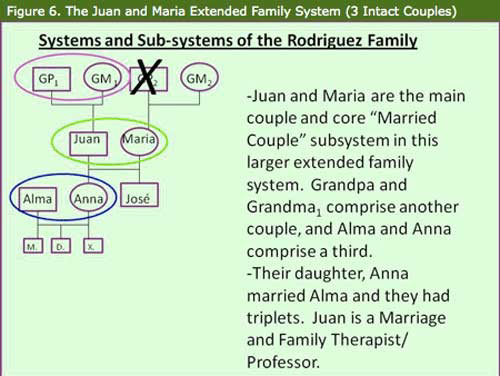
Those new babies have strained the entire family system, but extreme strain lands on Maria because Alma is a second year medical student and spends long hours in class and training. Anna is extremely overwhelmed by bottle-feedings, diapers, and other hands-on baby care demands. So, Maria is supporting both her daughter and three grandsons, but it's overwhelming. Look at Figure 7 Below.
Maria is the Matriarch of this family system. She simultaneously belongs to the following subsystems, Daughter-Mother, Daughter-in-law-Father & Mother-in-law, Spousal, Mother-Son, Mother-Daughter, Mother-in-law-Son-in-law, and Grandmother-grandchildren. Normally a large number of subsystems in one's life does not imply strain or stress. But, Juan and Maria have very demanding circumstances with Maria providing caregiving to Juan's Mother, caregiving to her post-childbirth daughter, Anna, and to the newborn triplets. Maria consults with Juan during a diner date. Juan holds a family meeting on Sunday evening. In it Juan's father volunteers to help Anna with the feeding and holding of the triplets. Juan arranges for elder-care nursing for his mother.
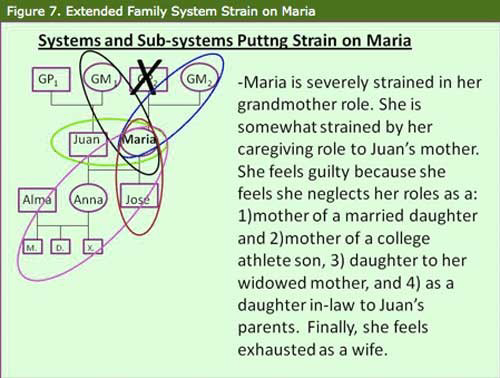
Anna decides to hire a team of teenaged young women to work hourly as her assistants. Maria's mother feels that she can help with meal preparation. Interestingly, Maria insists that she continue to contribute as a grandmother and on the weekend with Juan's mother (perhaps she felt the need to fulfill her role expectations and preserve some self-dignity). All agree and move forward. Juan, as do many Marriage and Family Therapists, already knows that a by looking at the family as a complex system with inter-locking and interdependent subsystems, solutions can be found among the members of the system and subsystems.
This brings up the issue of boundaries. "Boundaries” is a concept used in human relationships and family systems which are basically defined as distinct: emotional, psychological, or physical separateness between individuals, roles, and subsystems in the family. Boundaries are crucial to healthy family functioning. In my many years of teaching Family Systems theory I have found that the “My House, My Boundaries” (developed by Ron J. Hammond, 1998) metaphor is very useful in understanding why and how healthy and unhealthy boundaries impact the family systems as strong as they do (See Figure 8 below).
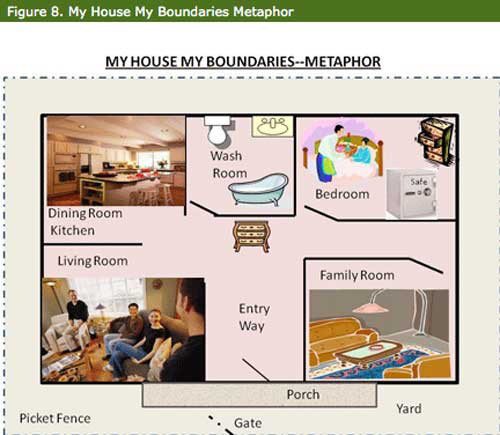
My House, My Boundaries
Social scientists have known for years that boundary maintenance is important for healthy relationships. From the Family Systems perspective we learn that family subsystems need to be maintained properly so that the overall family system functions properly. It is also important that interpersonal boundaries be maintained. But how exactly does one maintain them in our families which tend to be diverse and complex? One answer is to use the house paradigm of personal boundaries. Think of yourself as having a personal house which exists in the suburbs of your many relationships. We put locks and latches on our real house doors and windows to keep intruders out. This paradigm will teach you how to put relationship locks and latches on our personal house so that only those you choose to invite into your house will be allowed in and at a level of interaction that you are comfortable with.
Each of us has the responsibility of taking charge of our own house. That means we choose which people we invite in, when they are invited in, and which level of closeness in our house we allow them to share with us. We also have the responsibility of ensuring that we don't violate others' house boundaries. Look at the floor plan included here. Think of it in terms of varying levels of intimate or personal interaction with others. The gate is the most superficial level of interaction; whereas the bedroom is the deepest level. Let's consider each part of the house and its level of intimacy. The Gate is where we typically interact with strangers. We say hello, hi, how's it going'? We often don't really want to have the person respond. These are simply polite greetings we use with people we don't know.
The Porch & Entry Way is for people you are getting to know better, say another student you sit next to in class. You might begin to share personal information about your name, where you are from, or your major. At these levels you rarely share extremely personal information. That is reserved for people you have known for a long time and already trust.
Let's say that after a few weeks of school, you form a study group including the classmate you previously introduced yourself to. After a few tests and projects, you find that everyone in the study group has been sharing personal information. This might include information about your family, career aspirations, struggles with your parents, and the like. You are now interacting at the Living Room level in your house. You share information but are still guarded about the more vulnerable things about yourself.
In the Kitchen you share more personal information. This you might do with someone you are going steady with, dating, or feel very close to. In this level of interacting, you have deeply established trust and can share your fears, concerns, weaknesses, and hopes with someone in conversation. In the kitchen, confidences are kept. Each knows and respects this fact. The kitchen is often the deepest level of intimacy outside of marriage, cohabitation, or long-term commitments. The Bedroom represents the level of intimacy that spouses and partners experience. Here a person expresses intimacy at the most intimate level. You can think of the bedroom as representing a haven where physical and emotional intimacy can flourish. In the bedroom we are seen by our partner in our naked form. This implies that we are our true naked self here. In other words, our spouse or partner accepts us and interacts with us knowing our less apparent flaws. But even for couples, boundaries must be maintained. Each of us has a Safe.
Our safe represents the most intimate, vulnerable, and personal part of who we are. We rarely open it, even for our spouse or partner. When we do open it we must train our significant other to treat its contents with the utmost in respect and dignity. This takes practice, time, and lots of forgiveness for couples to achieve. Only we know the combination to our safe and we choose when to open and close it. You will notice that the bedroom can be attached to another bedroom. You and your spouse or partner each have your own house and each interact in each other's bedroom simultaneously.
Often newlyweds have the challenge of removing extended family members from the bedroom level (especially parents).
We have heard horror stories of parents interfering with their married children's relationship by giving unsolicited financial, sexual, and/or contraceptive advice; setting up financial deals which keep the children indebted to them; and over involving their married children in their family so that their children have to struggle to establish their own marriage traditions and customs. Couples sometimes have to be extremely diligent in removing the parents or other offenders from their bedroom issues. If this is the case for you keep in mind that in the long run, it will be worth it. Relationships tend to be healthier and people tend to be happier when boundaries are maintained. The other two rooms represent unique concepts in this paradigm.
The Washroom represents a place where you can clean up the messes people sometimes bring into your house. For example, sometimes parents get too personal with their newly married children and can be offensive at times. After you and your spouse or partner remove them to the level of interacting you are comfortable with, you can symbolically wash their muddy footprints out of your rug, forgive, and get on with things. The Family Room represents the level of interacting that is appropriate to the family but not necessarily to others outside of the family system. Family jokes, stories, traditions, and other appropriate interactions occur in this room.
When family boundaries are violated there tends to be two forms of violation. Home invasion where the individual inserts themselves into the your intimate life uninvited (e.g., “how much money do you make?; why do you keep making the same mothering mistakes over and over?; or what types of sexual maneuvers do you practice?”). Then there is the Abduction, where the individual kidnaps you into his or her personal intimacies against your will (e.g., Let me tell you what my partner and I did in bed last night…; my husband is such a loser when it comes to making money. Just last week he got passed over for a promotion…; or my mom gives her pain meds to any of us children who ask.”). Neither the home invasion nor abduction is healthy when unwanted or invited.
As was mentioned before, you are responsible for maintaining the level of interaction in your house. You should interact at levels that you define as comfortable and appropriate for you. Many in our society are conditioned not to respect boundaries and most who don't are not even aware of why it is such an unhealthy practice. There are numerous methods you can use to either remove an intruder from rooms in your house or to remove yourself if you are invited into someone else's house at a level you are not comfortable with.
First, you might distract the other person by changing the subject or talking to another person in the room. Make sure NOT to give approval to those who violate boundaries, since many are hungry for constant affirmations and will continue to violate boundaries if it rewards them this way. Second, you might educate the person about boundaries and the level of intimacy he or she is interacting on and why you are uncomfortable with it. Third, you might also consider harshly confronting the other person (the sooner the better in most relationships) or if your previous efforts appear to have brought little change in the relationship. Fourth, and most extremely, you may need to sever destructive relationships where boundary violations threaten the unity and cohesiveness of the family system (e.g., a person seeking extramarital intimacy).
You are the very best judge of specifically how to maintain your personal boundaries. Keep in mind that this paradigm is based on the belief that personal boundary maintenance is really about interacting with others based on your true feelings, needs, and wants. It is not about controlling others. It is about self-control and to a large degree honesty with our self. We have included a worksheet to assist you in thinking through those strategies you might employ for specific people. We have given you an example of a generic floor plan of the house (you would do best to draw your own). In the Workbook there is a self-study questionnaire, worksheet, disposition toward theories, and a boundary maintenance questionnaire to help you personalize these principles.


